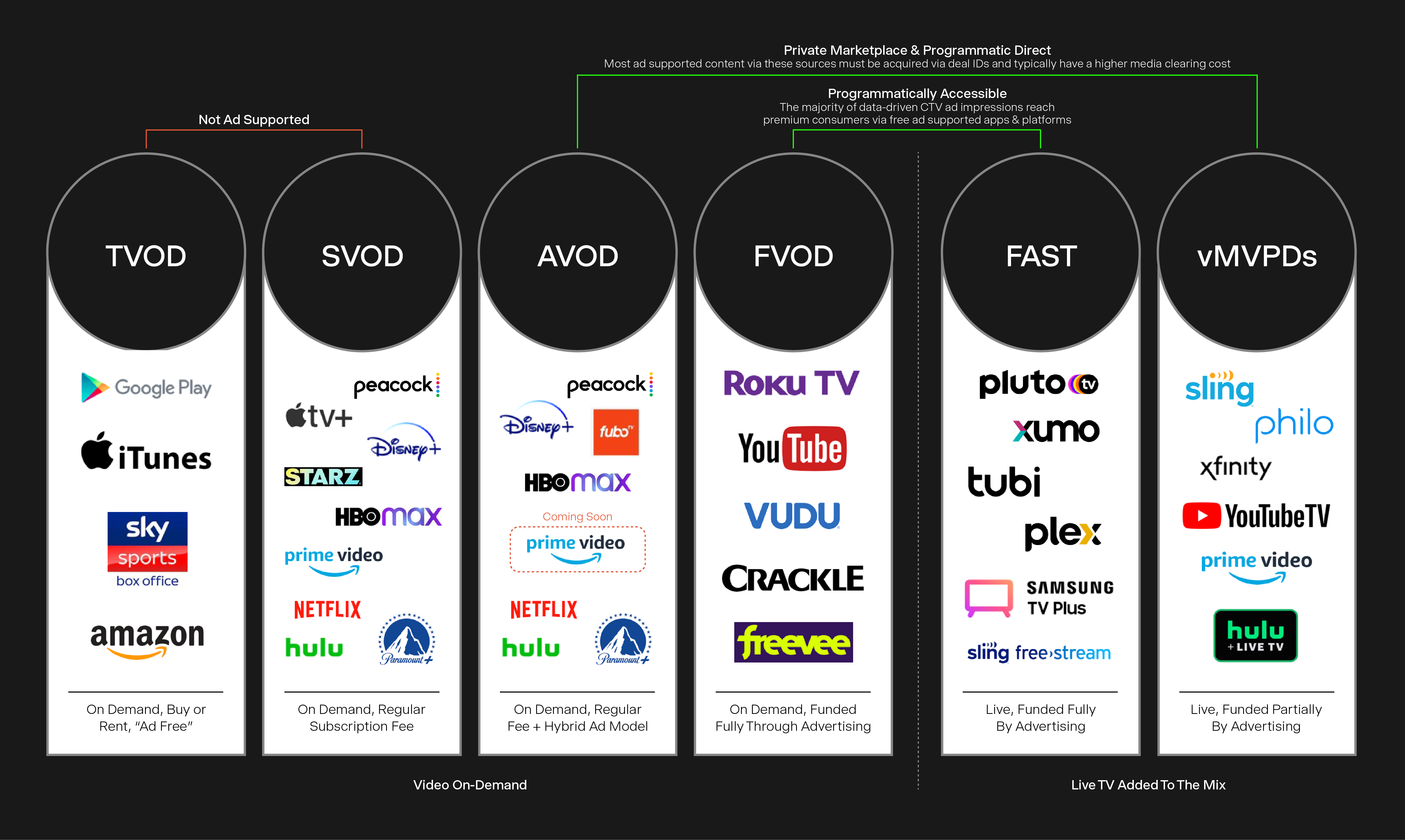Navigating the Evolving Landscape of TV and Digital Advertising: A Guide for Today’s Advertisers
As consumers increasingly turn to streaming TV, understanding the nuances of this fragmented market is key.
Written by: Aaron Michael Buch
In the rapidly changing world of advertising, understanding the various platforms and their nuances is crucial. From traditional TV to the dynamic realm of Connected TV (CTV) and digital advertising, this guide provides an overview of different advertising platforms, their estimated CPMs, factors affecting these costs, and the targeting capabilities each offers, complete with specific examples.
Understanding CPM in Different Advertising Contexts
1. Prime Time Linear TV (Traditional Broadcasts)
- Estimated CPM: High
- Examples: NBC’s “The Voice,” CBS’s “NCIS”
- Variability Factors: Time slot, channel popularity, audience demographics.
- Targeting Capability: Broad, with limited personalization.
2. Premium Digital Video Platforms (e.g., Hulu, YouTube Premium)
- Estimated CPM: Moderate to High
- Examples: Hulu’s exclusive series, YouTube Premium content
- Variability Factors: Content type, viewer demographics, ad format.
- Targeting Capability: Good, with demographic and interest-based options.
3. Connected TV (CTV) and Its Categories
- AVOD (Advertising Video On Demand): Moderate CPM, examples include Hulu (ad-supported version), Peacock. Variability depends on content popularity and targeting options, with good audience targeting.
- FAST (Free Ad-Supported Television): Moderate CPM, examples include Pluto TV and Tubi. Influenced by channel type and viewer data, offering a mix of broad and targeted advertising.
- vMVPD (Virtual Multichannel Video Programming Distributor): Moderate to High CPM, with examples like Sling TV and YouTube TV, offering cable-like targeting with more digital flexibility.
4. Geo-Fencing and Location-Based Ads
- Estimated CPM: Moderate to High
- Examples: Ads targeted within specific areas in shopping malls or event venues
- Variability Factors: Location specificity, audience size.
- Targeting Capability: Highly precise, ideal for local and event-focused campaigns.
5. Social Media Platforms (e.g., Facebook, Instagram)
- Estimated CPM: Moderate, but variable
- Examples: Facebook video ads, Instagram sponsored posts
- Variability Factors: Targeting specificity, ad format, platform competition.
- Targeting Capability: Highly detailed, with numerous demographic and behavioral options.
6. Search Engine Advertising (e.g., Google Ads)
- Estimated CPM: Varies
- Examples: Google search ads for specific keywords
- Variability Factors: Keyword competitiveness, industry sector.
- Targeting Capability: Based on user search intent and demographics.
7. Out-of-Home Advertising (e.g., Billboards, Transit Ads)
- Estimated CPM: Variable
- Examples: Digital billboards in Times Square, bus wrap ads
- Variability Factors: Location, visibility.
- Targeting Capability: Geographic focus, broader audience reach.
Key Takeaways for Advertisers
- Evolving Landscape: Each platform, from traditional TV to CTV and digital, offers unique opportunities and challenges.
- Targeting vs. Reach: Platforms like AVOD and FAST provide a balance between precise targeting and broad reach.
- Programmatic CTV: Leverage programmatic options in CTV for effective ad placements. Private Marketplaces and Programmatic Direct deals can offer valuable opportunities.
- Budget Allocation: Weigh CPM against expected ROI. Higher CPMs might be justified by better engagement or more precise targeting.


